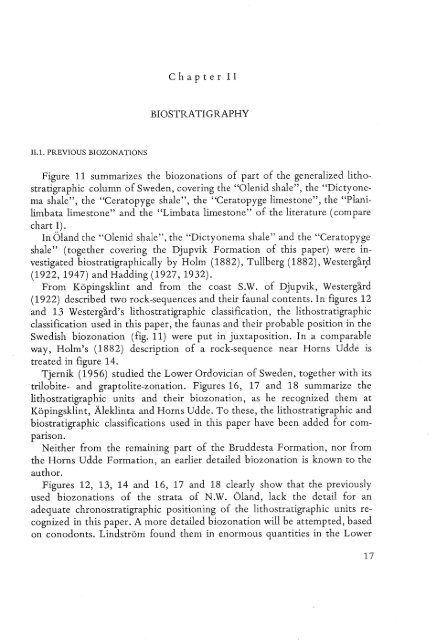UTRECHT MICROPALEONTOLOGICAL BUllETINS
UTRECHT MICROPALEONTOLOGICAL BUllETINS
UTRECHT MICROPALEONTOLOGICAL BUllETINS
You also want an ePaper? Increase the reach of your titles
YUMPU automatically turns print PDFs into web optimized ePapers that Google loves.
Figure 11 summarizes the biozonations of part of the generalized lithostratigraphic<br />
column of Sweden, covering the "Olenid shale", the "Diety onema<br />
shale", the "Ceratopyge shale", the "Ceratopyge limestone", the "Planilimbata<br />
limestone" and the "Limbata limestone" of the literature (compare<br />
chart I).<br />
In Oland the "Olenid shale", the "Dictyonema shale" and the "Ceratopyge<br />
shale" (together covering the Djupvik Formation of this paper) were investigated<br />
biostratigraphic ally by Holm (1882), Tullberg (1882), Westergar,d<br />
(1922,1947) and Hadding (1927,1932).<br />
From Kopingsklint and from the coast S.W. of Djupvik, Westergard<br />
(1922) described two rock-sequences and their faunal contents. In figures 12<br />
and 13 Westergard's lithostratigraphic classification, the lithostratigraphic<br />
classification used in this paper, the faunas and their probable position in the<br />
Swedish biozonation (fig. 11) were put in juxtaposition. In a comparable<br />
way, Holm's (1882) description of a rock-sequence near Horns Udde is<br />
treated in figure 14.<br />
Tjernik (1956) studied the Lower Ordovician of Sweden, together with its<br />
trilobite- and graptolite-zonation. Figures 16, 17 and 18 summarize the<br />
lithostratigraphic units and their biozonation, as he recognized them at<br />
Kopingsklint, Aleklinta and Horns Udde. To these, the lithostratigraphic and<br />
biostratigraphic classifications used in this paper have been added for comparison.<br />
Neither from the remaining part of the Bruddesta Formation, nor from<br />
the Horns Udde Formation, an earlier detailed biozonation is known to the<br />
author.<br />
Figures 12, 13, 14 and 16, 17 and 18 clearly show that the previously<br />
used biozonations of the strata of N.W. bland, lack the detail for an<br />
adequate chronostratigraphic positioning of the lithostratigraphic units recognized<br />
in this paper. A more detailed biozonation will be attempted, based<br />
on conodonts. Lindstrom found them in enormous quantities in the Lower
















